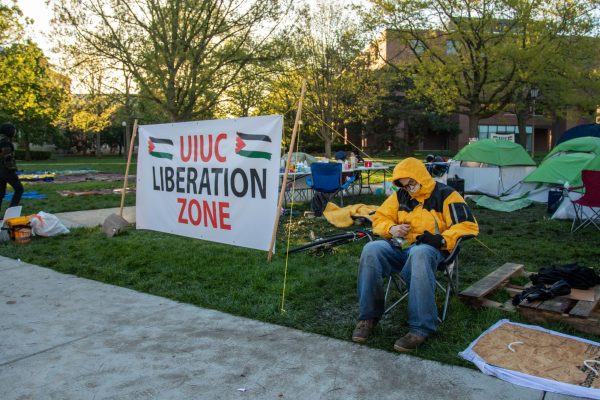Champaign County should invest in wind energy, researchers suggest
May 8, 2023
Dozens of snow-white turbines spring up from green fields, standing at around 260 feet tall.
Thirty-five minutes away from the University, Sapphire Sky Wind Energy Center in Farmer City, Illinois is one of the closest wind farms to Champaign County.
While other counties in Illinois and nearby states take action when it comes to wind energy development, Champaign County is slow, primarily because of the social “stigma” among landowners, not willing to sacrifice their land for wind turbines, experts say.
According to a Stanford study, wind energy is one of the most promising renewable energy sources because of its ability to reduce the emissions of energy production by 99%.
According to the U.S. Energy Information Administration, the minimum required wind speed for the stable functioning of wind turbines is nine mph; the average wind speed in Champaign County is 18.43 mph, according to USA.com.
Get The Daily Illini in your inbox!
However, the county’s weather conditions have not fueled wind energy development.
The County Board gave their approval for one small wind farm back in 2011, said John Hall, director of the Planning and Zoning Department of Champaign County. However, wind energy development stopped after that.
According to Hall, one of the main reasons for the lack of wind energy in Champaign County is landowners’ unwillingness to give their land for wind farms.
“Over the past couple of years there’s been a couple of wind farms trying to sign up landowners,” Hall said. “The fact that that hasn’t materialized into an actual application makes me think that they’re having trouble lining up enough landowners to want to sign up for a wind farm on their property.”
And this reason can be explained by the amount of land required for the proper functioning of wind farms, said Lucas Buccafusca, a professor at Johns Hopkins University who focused his research on wind farm arrays while studying at the University of Illinois.
“These turbines are very large, and they interfere with each other destructively in the sense that wind passing through one turbine causes turbulence, so downstream turbines are less efficient,” Buccafusca said.
This creates a need for large amounts of space between turbines, Buccafusca said.
However, Buccafusca said the social stigma around turbines and their effects on people’s health hinders wind energy development.
“In general, there’s a negative perspective about having a large wind turbine in your backyard,” Buccafusca said.
Buccafusca emphasized the importance of psychological factors in this issue.
“Some of the psychological side effects have been demonstrated to be nocebo effects when people say, ‘Oh, they installed a wind turbine near me, I was starting to get headaches and get sick,’” Buccafusca said.
These concerns are unjustified and caused by the lack of understanding of wind energy in general, Baccafusca said.
“People just believe it will make them sick, at no point it does, and people say that they’re loud, they’re actually not that loud, and there’s people say they’re close, well, they’re actually federally mandated laws that require them to be certain distances away from any habitations,” Buccafusca said.
Among the advantages of wind energy, its lack of pollutants and geographical universality stand out, said Leonardo Patricio Chamorro Chavez, associate professor in Engineering.
“Wind power is available everywhere,” Chavez said in an email. “Wind turbines can be placed in a variety of locations, including complex terrains and offshore areas, utilizing both floating and fixed platforms.”
“A significant advantage of wind energy is its minimal environmental impact,” Chavez said. “Unlike fossil fuels, wind energy generates no greenhouse gases or other harmful pollutants, making it a critical player in climate change mitigation.”
Another important advantage of wind energy over other alternatives is its cost efficiency, said Lucy Pao, professor in the Department of Electrical, Computer, and Energy Engineering at the University of Colorado Boulder.
“Wind energy, of course, is a clean and renewable energy source, now the cost of wind energy is lower in some regions compared to natural gas and coal and other sources of energy,” Pao said. “And I guess for Champaign, wind farms can be sited in conjunction with agricultural farms, so that can be a win-win situation.”
Pao said a mixture of agricultural farms and wind farms worked well in Iowa, a state located right next to Illinois which has the second most developed wind energy industry in the nation, according to Choose Energy.
“In Iowa, there’s definitely a lot of the wind farms sited in conjunction with the agricultural farms there and have been very successful,” Pao said. “And so then the farmers have this additional source of income through allowing the wind farms to be sited on their agricultural farms.”
Pao proposed wind farms could make landowners money, giving them access to low-cost energy, which they can then sell to other companies. This system would mimic solar energy models currently in place.
Hall, on the other hand, believes that residential solar and wind energy are completely different, in the eyes of landowners as well.
“I think it’s just much easier to do rooftop solar as compared to installing a small wind turbine tower on your own private property,” Hall said.
However, Pao still believes that wind energy acceptance is almost inevitable.
“The population is growing a bit, and we need more sources of electrical energy, and then you look at the alternatives: Do we want a coal plant down the road, or nuclear power plant, and when you consider the choices there, versus having a wind farm, then maybe a wind farm might be the better option,” Pao said. “It’s a matter of weighing the pros and cons of each of the choices.”
Rudy Lafave, sophomore in AHS and Illinois resident, also thinks Champaign County needs to transition to green energy.
However, as an environmental policy student, Lafave drew attention to the ecological issues caused by wind turbines.
“Migratory birds have a problem with wind energy, they often hit the turbines,” Lafave said. “But people are working on solutions, all the time identifying directory for migratory bird habitat, and making sure to specifically not place windmills or to lessen that density as such.”
This is not the only disadvantage of this renewable energy source; another is its changing availability, Chavez said. Since the energy source is wind, energy delivery directly depends on the season and weather conditions, however, energy storage systems are the solution.
“Wind power is an inherently variable resource, and its availability may fluctuate considerably based on several factors, including time of day, season, weather conditions and geographical location,” Chavez said in the email. “Implementing energy storage solutions or backup power systems may be necessary to ensure a dependable electricity supply.”
However, Chavez believes that potential positive effects of wind energy development on the region’s infrastructure can outweigh these disadvantages.
“The wind energy industry would yield enhancements to both employment opportunities and infrastructure,” Chavez said in the email. “Wind farms require access roads, transmission lines, and electrical substations, thereby boosting the development of the region’s infrastructure.”
When thinking about possible solutions for the issue of underdeveloped wind energy in Champaign, Buccafusca suggested education.
“I think knowledge is power in that right,” Buccafusca said. “Getting people to understand that many of the potential benefits can outweigh their concerns is essential.”
According to Pao, to achieve acceptance of wind energy on the social level, it is important to build wind farms in collaboration with the community, considering their needs and perspectives when discussing wind energy.
“I think something in terms of societal acceptance, just to be working with the community and for the community, for them to learn as much as they can both the pros and cons,” Pao said. “So they can decide whether they want to go forward with having wind energy locally.”
Lafave, in turn, brought up the possible solution through the monetary motivation of landowners to provide their land for wind farms.
“One of the biggest things that the Champaign County can do is offer either tax subsidies to farmers, or tax credits to form wind farms on their land,” Lafave said. “There are definitely ways of being able to sell this to farmers for personal gain. Offering tax breaks and subsidies can definitely help monetarily incentivize these actions to happen.”
Even though there is no official information about new wind farms coming to Champaign County, professional engineers think that considering the global environmental situation, green energy development is just a matter of time.
“The rapid progression of climate change means that coming up with alternative energy solutions is borderline necessary for maintaining a stable planet,” Buccafusca said. “I believe that there’ll be a change in the social beliefs that will encourage people to explore that (wind) potential energy in the future.”







